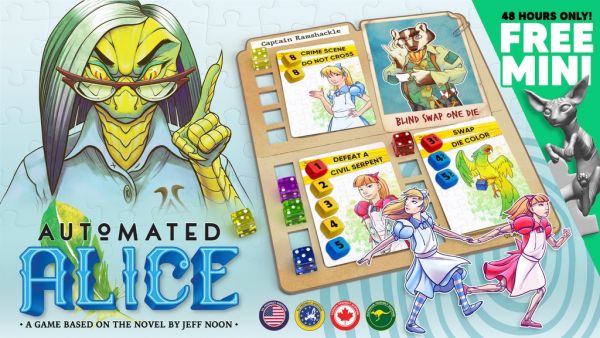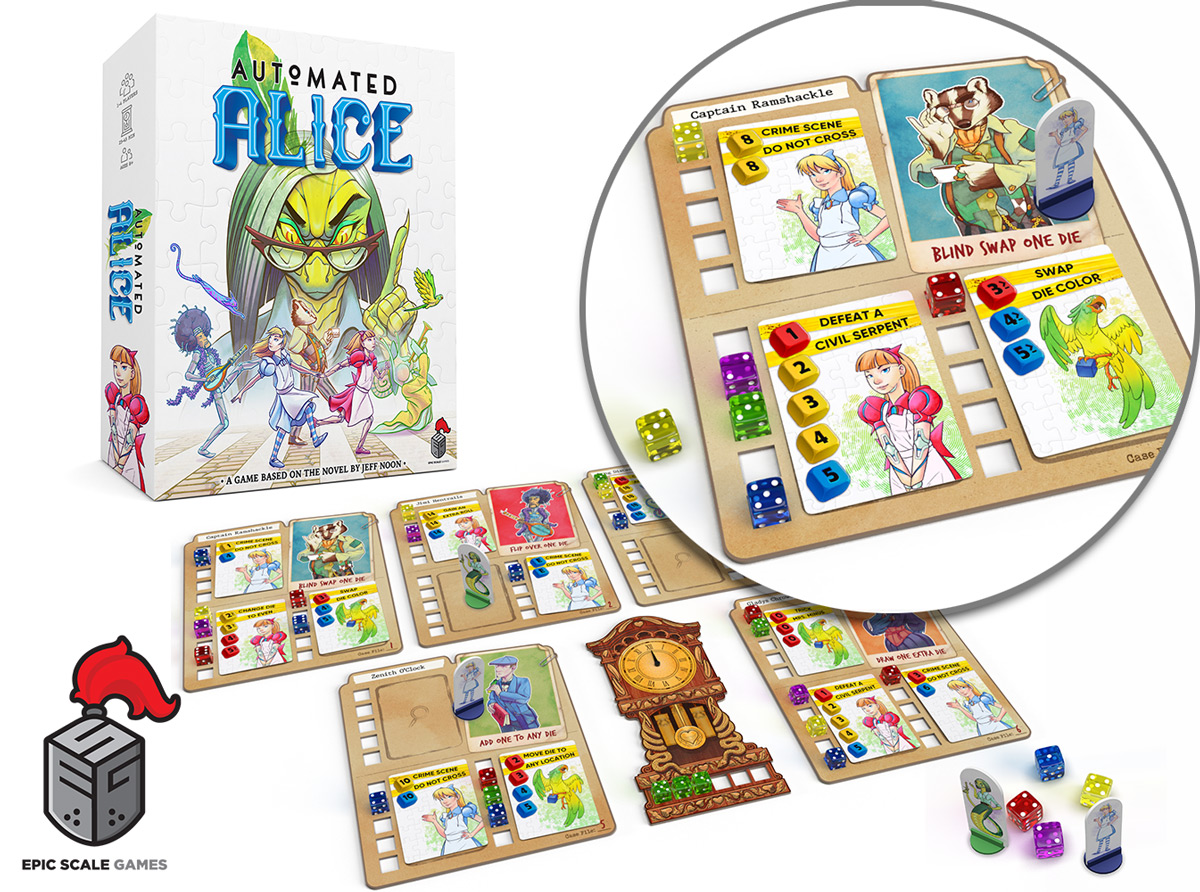Preview: Wonderland, Clues, Cooperation, and Dice Rolling in Automated Alice

Alice is once more in Wonderland, and this time she is the suspect of a string of murders. Can you help her clear her name and save her from Mrs. Minus and her civil serpents?
Currently on Kickstarter, Automated Alice is a cooperative dice placement game from Epic Scale Games that is based on a novel by Jeff Noon. Players roll dice, placing them on clue cards, while trying to use character and card abilities as effectively as possible.
Gameplay
There are six case file boards. During setup, two clue cards are dealt face up to each board in a one-to-two player game, and three for a three-to-four player game. A die is rolled to determine which case file Mrs. Minus starts on. The game is played over a set number of rounds (the number varies on player count), with every player getting one turn in each round.
On the start of your turn you may move Alice to any case file (or leave her where she is). You may not move Alice to the same case file that Mrs. Minus is on, and if Mrs. Minus has moved to Alice's present location you must move Alice. Next, you take four random dice out of the dice bag and roll them.
Each clue card requires certain dice of certain colors in order to complete. Some clue cards require those exact colored dice to match exact numbers or to match or be higher, others require you to play only odd or even numbered dice, and one type requires the dice to combine to equal or exceed a set total.
Dice come in five different colors. Red, blue, and yellow are regular dice and are the three colors that clue cards call for. Purple dice are wild, and can count as any of these three colors. Green dice are civil serpents and are in league with Mrs. Minus.
You must first deal with any green dice you rolled. When you roll a civil serpent, you must attempt to place it on a clue card at Alice's present case file location, placing it on a clue card's die space whose number matches the green die's result. If you cannot legally place a civil serpent, it goes into the civil serpent threat tracker location. If there are ever six dice there, you lose the game.
A civil serpent die must be defeated before you can complete the clue card it is on. In order to defeat it, you must match both the number on the civil serpent die and the color shown on the die space it is occupying. Then both the civil serpent and the die you used to defeat it are returned to the dice bag.
After placing any green dice you rolled, you may place any dice on Alice's current location that you are able to and wish to. You have two rerolls, and before each one you may choose to stay at Alice's current location or move to another case file board. Each case file has a special ability associated with it, which Alice may use while on that case file, once per turn. Some completed clue cards will also give you a special ability that you can use once during the game. Any dice you do not manage to place before the end of the turn are placed in the Hold. The only way to remove dice from the Hold is to advance one hour on the clock, losing a game round.
Dice remain on a clue card until the clue card is completed. They are then all removed from the card and returned to the dice bag.
At the beginning of each round, you roll the Mrs. Minus die to see where she moves. If she moves to Alice's location, you draw a civil serpent from the dice bag, roll, and place it (if you cannot place it on the case file it goes to the civil serpent tracker).
Players win the game if they collect all clue cards before the final round is over. If you fail to do so, you lose the game. You also lose if you do not have enough dice left in the dice bag to complete any of the remaining clue cards or if the civil serpent threat tracker is filled.

Review
Automated Alice is a fun mixture of luck of the roll and strategically using the options open to you. It’s bright and colorful, has a really fun table presence with all the case files and clue cards, and its rules are easy to learn and teach — making it a great casual dice game with enough depth to keep everyone engaged.
The range of abilities is where the challenge of the game really comes through. Figuring out the best way to move from case file to case file, using their abilities while also choosing locations where you have the best chance of placing your dice, is where the strategy of the games lies, and where players will be discussing optimal moves.
Additionally, there is a nice sense of escalation built into the gameplay. As more and more clue cards come off the boards, it becomes more and more difficult to place dice, ensuring that more dice go to the Hold and civil serpents become more dangerous. You are also more often faced with press-your-luck choices, balancing risky rolls against having to send dice to the Hold at the end of your turn.
It’s tempting in the early game to spend your clue card abilities often, but they’re vital in the end game when bad rolls start hurting you more. Further adding to the difficulty is that, as the game progresses, Alice may not move to a case file where all clue cards have been completed, meaning that more and more character abilities are lost to you as you progress.
There is a little bit of a scaling issue across player counts, as in a two-player game you only have two clue cards per case file, despite having as many turns among the players as you do in a four-player game. Players also have more turns in a three-player game, although the number of dice you need overall varies based on the clue cards dealt during setup, which can balance out this issue.
We really enjoyed the theme of the game. While not familiar with the novel Automated Alice, the blend of the familiar Alice in Wonderland setting with unique characters was a lot of fun. It felt familiar but fresh. The final version of the game will also feature die-cut spaces for the dice on the case files and on the civil serpent tracker, ensuring dice will slot in nicely and not easily be knocked around. The colorful and cheerful artwork of the game is also perfect for the theme and lightness of the gameplay.
Automated Alice is a great addition to the dice placement genre. There are all those moments you want in a dice game: groans when Mrs. Minus moves exactly where you don’t want her to or when a risk doesn’t pay off, and cheers when you roll exactly what you needed. Players are given plenty of choices, so they never feel like the dice are playing the game and not them. If you enjoy dice games, definitely check it out on Kickstarter.
Pros: Plenty of player choice, theme and components, good escalation in the endgame
Cons: Some difficulty scaling issues across player count.
Disclosure: this preview is based on our evaluation of an unpublished prototype of the game, which is subject to change prior to publication. While a modest payment was received to expedite the review process, our thoughts and opinions expressed here are honest and accurate.




